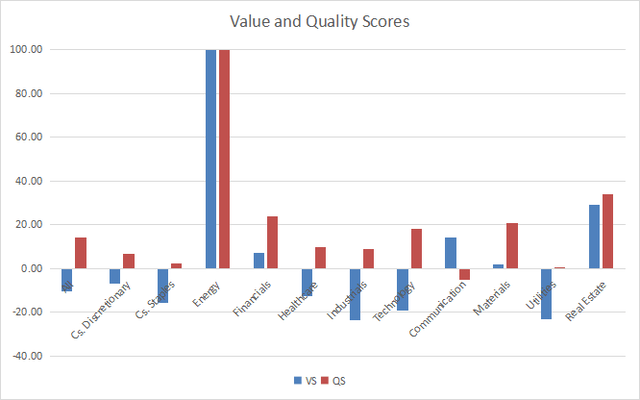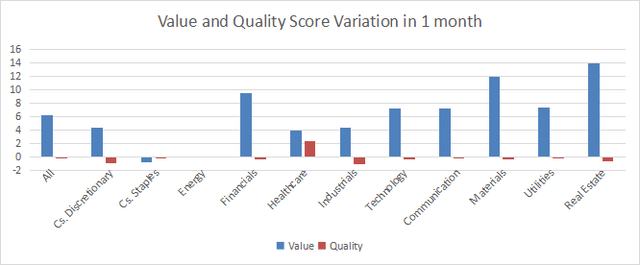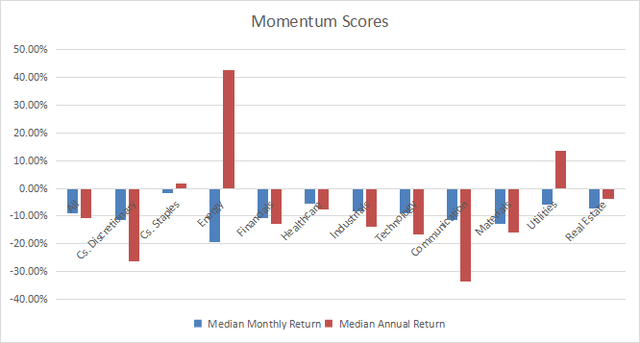[ad_1]
Blue Planet Studio/iStock via Getty Images
This monthly article series reports sector metrics in the S&P 500 index. It is also a top-down analysis of all ETFs based on the S&P 500.
Fast facts on RSP
The Invesco S&P 500 Equal Weight ETF (NYSEARCA:RSP) holds all S&P 500 stocks in an equal-weight portfolio rebalanced quarterly. The expense ratio is a bit higher than for the SPDR S&P 500 ETF Trust (SPY): 0.20% vs. 0.09%. RSP is supposed to outperform SPY on the long-term by playing the size factor (smaller companies have a higher weight than in the capital-weighted index) and the rebalancing mechanism (“sell high, buy low”). The equal-weight S&P 500 has beaten the capital-weighted index by about 2% in annualized return since 1999, and by about 1% since RSP inception (04/24/2003). However, it has slightly underperformed in the last few years.
Shortcut
The next two paragraphs in italic describe the dashboard methodology. They are necessary for new readers to understand the metrics. If you are used to this series or if you are short of time, you can skip them and go to the charts.
Base Metrics
I calculate the median value of five fundamental ratios in every sector: Earnings Yield (“EY”), Sales Yield (“SY”), Free Cash Flow Yield (“FY”), Return on Equity (“ROE”), Gross Margin (“GM”). All are calculated on trailing 12 months. For all these ratios, higher is better and negative is bad. EY, SY and FY are medians of the inverse of Price/Earnings, Price/Sales and Price/Free Cash Flow. They are better for statistical studies than price-to-something ratios, which are unusable when the “something” is close to zero or negative (for example, companies with negative earnings). I also calculate two momentum metrics for each group: the median monthly return (RetM) and the median annual return (RetY).
I prefer medians rather than averages because a median splits a set in a good half and a bad half. Capital-weighted averages are skewed by extreme values and the largest companies. As a consequence, these metrics are designed for stock-picking rather than index investing.
Value and Quality Scores
Historical baselines are calculated as the averages on a look-back period of 11 years for all metrics. They are noted respectively EYh, SYh, FYh, ROEh, GMh. For example, the value of EYh for technology in the table below is the 11-year average of the median Earnings Yield of S&P 500 tech companies.
The Value Score “VS” is the average difference in % between the three valuation ratios (EY, SY, FY) and their baselines (EYh, SYh, FYh). The same way, the Quality Score “QS” is the average difference between the two quality ratios (ROE, GM) and their baselines (ROEh, GMh).
VS may be interpreted as the percentage of undervaluation or overvaluation relative to the baseline (positive is good, negative is bad). This interpretation must be taken with caution: the baseline is an arbitrary reference, not a supposed fair value. The formula assumes that the three valuation metrics are of equal importance, except in energy and utilities where the Free Cash Flow Yield is ignored to avoid some inconsistencies. VS and QS are capped between -100 and +100 when the calculation goes below this value.
Current data
The next table shows the metrics and scores as of last week’s closing. Columns stand for all the data defined above.
|
VS |
QS |
EY |
SY |
FY |
ROE |
GM |
EYh |
SYh |
FYh |
ROEh |
GMh |
RetM |
RetY |
|
|
All |
-10.35 |
14.26 |
0.0457 |
0.3589 |
0.0270 |
18.27 |
48.37 |
0.0456 |
0.4541 |
0.0301 |
14.86 |
45.81 |
-9.12% |
-10.59% |
|
Cs. Discretionary |
-7.01 |
6.91 |
0.0479 |
0.6037 |
0.0274 |
24.78 |
34.96 |
0.0469 |
0.6679 |
0.0317 |
20.97 |
36.55 |
-11.38% |
-26.25% |
|
Cs. Staples |
-15.67 |
2.41 |
0.0396 |
0.4352 |
0.0180 |
26.56 |
37.81 |
0.0447 |
0.5053 |
0.0230 |
23.55 |
41.09 |
-1.70% |
1.70% |
|
Energy |
100.00 |
100.00 |
0.0681 |
0.4711 |
0.0511 |
17.68 |
47.61 |
0.0169 |
0.5354 |
-0.0170 |
4.83 |
42.38 |
-19.24% |
42.59% |
|
Financials |
7.13 |
24.07 |
0.0949 |
0.3982 |
0.0685 |
14.41 |
81.01 |
0.0685 |
0.4588 |
0.0713 |
10.53 |
72.76 |
-10.64% |
-12.76% |
|
Healthcare |
-12.41 |
9.75 |
0.0360 |
0.2497 |
0.0323 |
19.19 |
63.27 |
0.0379 |
0.3067 |
0.0374 |
16.22 |
62.51 |
-5.47% |
-7.48% |
|
Industrials |
-23.66 |
9.15 |
0.0403 |
0.3917 |
0.0227 |
24.02 |
37.05 |
0.0474 |
0.5888 |
0.0293 |
20.37 |
36.92 |
-8.32% |
-13.87% |
|
Technology |
-18.98 |
18.13 |
0.0375 |
0.2156 |
0.0292 |
27.59 |
64.36 |
0.0409 |
0.2909 |
0.0378 |
20.68 |
62.57 |
-8.94% |
-16.46% |
|
Communication |
14.38 |
-4.94 |
0.0585 |
0.6375 |
0.0405 |
14.92 |
55.16 |
0.0493 |
0.5262 |
0.0392 |
16.73 |
54.65 |
-11.41% |
-33.58% |
|
Materials |
2.04 |
20.93 |
0.0538 |
0.5640 |
0.0241 |
23.13 |
37.23 |
0.0446 |
0.6250 |
0.0253 |
16.73 |
35.95 |
-12.74% |
-15.90% |
|
Utilities |
-23.30 |
0.78 |
0.0461 |
0.3590 |
-0.0621 |
9.05 |
42.19 |
0.0517 |
0.5590 |
-0.0452 |
9.69 |
38.99 |
-5.97% |
13.52% |
|
Real Estate |
29.00 |
34.10 |
0.0304 |
0.1035 |
0.0097 |
10.20 |
65.25 |
0.0202 |
0.1156 |
0.0066 |
6.06 |
65.44 |
-7.33% |
-3.67% |
Score charts
The next chart plots the Value and Quality Scores by sectors (higher is better).
Value and quality in the S&P 500 (Chart: author; data: Portfolio123)
Score variation since last month:
Variations in value and quality (Chart: author; data: Portfolio123)
The next chart plots momentum data.
Momentum in the S&P 500 (Chart: author; data: Portfolio123)
Interpretation
A hypothetical S&P 500 “median” company is overvalued by about 10% relative to average valuation metrics since 2011. The quality score is 14 points above the baseline. We can translate median yields in their inverse ratios:
Price/Earnings: 21.88 – Price/Sales: 2.79 – Price/Free Cash Flow: 37.04
Energy is the most attractive sector regarding value, quality and momentum scores. Real estate, communication services and financials are undervalued relative to 11-year averages by 29%, 14% and 7% respectively. Real estate and financials also have excellent quality scores. Usual fundamental ratios are less meaningful in these two sectors, but comparing aggregate metrics to their own historical averages makes sense. Materials is close to the historical baseline in value and above it in quality. Other sectors are overvalued by 7% to 24% relative to the baseline. It may be partly justified by good quality scores for technology, consumer discretionary, healthcare, and to a lesser extent for industrials. Utilities, industrials and technology are the most overvalued sectors.
SPY is down -10.8% in 12 months (total return with dividends), the median return of the S&P 500 is -10.6% (reported above in the table) and the equal-weight average (measured on RSP) is -9.8% . These numbers are close, which means the S&P 500 was not skewed by mega-cap companies in this period.
We use the table above to calculate value and quality scores. It may also be used in a stock-picking process to check how companies stand among their peers. For example, the EY column tells that a large consumer staples company with an Earnings Yield above 0.0396 (or price/earnings below 25.25) is in the better half of the sector regarding this metric. A Dashboard List is sent every month to Quantitative Risk & Value subscribers with the most profitable companies standing in the better half among their peers regarding the three valuation metrics at the same time.
[ad_2]
Source links Google News

